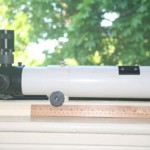Here's a quick guide to the essential features that you should look for when buying your first telescope.
Choosing Your Equipment – A Guide for Astonomers
What to Know Before Buying a Telescope
Looking through a telescope introduces you to a whole new world of unexpected wonders. But telescopes come in a huge range of sizes and shapes. Here's a detailed, printable guide to the essential features that every good scope needs to have.
How to Choose a Telescope
The incredible variety of telescopes presents a real challenge for first-time buyers. Here's a no-nonsense primer to an astronomical rite of passage.
Advanced Imaging Conference 2013 Vids
Watch senior editor Dennis di Cicco's interviews with vendors at the October 2013 Advanced Imaging Conference.
Photos with Celestron’s 14-inch EdgeHD
Here are some celestial photos taken with Celestron's new flagship telescope, the 14-inch EdgeHD.
SkyScanner 100 vs. 4.5-inch StarBlast
How does the little $100 scope stack up against its venerable bigger brother?
The Joy of Small Instruments
No photograph can compare with the experience of viewing Saturn directly — something that's possible with even the smallest telescopes.
Three Great, Small Reflectors
Orion Telescopes & Binoculars's XT4.5 and StarBlast 4.5 and Edmund Scientific's Astroscan set the standard of excellence for small, inexpensive, easy-to-use telescopes.
Travel Scopes
It's tough to reconcile all the different constraints placed on a telescope for the airplane-traveling stargazer.
Binocular Blogs
Binocular stargazing has a peaceful, organic quality that's hard to achieve through a telescope. Here's a list of some blogs the author has written on this subject.
Best Starter Telescopes
In the December 2005 issue of Sky & Telescope, Gary Seronik reviewed a collection of telescopes costing less than $200. It's quite likely that if we were to conduct the same survey today, we would still pick the same 5 as our top scopes.
The Amazing $20 Telescope
Sky & Telescope has reviewed innumerable telescopes, and only a handful of the ones that we've tried and liked cost less than $200. Now we're going to recommend a telescope that's selling for $20, and your response is going to be "you're kidding, right?" No, we're not!
Cheap Enough for a Cheap Scope?
What value would you put on a cheap scope like this?
Portaball Reborn
Mag 1 Instruments, maker of the Portaball Telescope, is alive and well under a new owner.
Capture the Sun with Your PST
High-quality hydrogen-alpha photography of the Sun can be done on a modest budget.
Tools for Stargazing
Learn how to get the most out of your binoculars, telescope, and more.
10 Top Telescope Questions
Here are common questions about telescopes culled from an expert’s mailbag.
Beating the Seeing
"Seeing" — the atmospheric quivering that fuzzes out high-power views — is the bane of every telescope user. Here's how to minimize its impact.
Take-Along Telescopes
Want a telescope to bring on your next vacation? Here are some things to consider when looking for a travel scope.
Telescope Buying Guide
A no-nonsense primer to an astronomical rite of passage.
How to Start Right in Backyard Astronomy
Astronomy doesn't deserve its reputation as a tough, expensive hobby. You just need to begin with the right advice.
The Art of Using a Telescope
Congratulations — you've followed our advice and bought the telescope that's best for you. Now learn how to get the most out of it.
The Spectral Types of Stars
Without its spectral type, a star is a meaningless dot of light.
The Stellar Magnitude System
Why do larger numbers mean less light? Here's the story of astronomy's odd but beloved scheme for describing star brightnesses.
An Eyepiece Primer
To get the most from your telescope, you need the right eyepieces. Here's what you need to know to make smart choices.

























